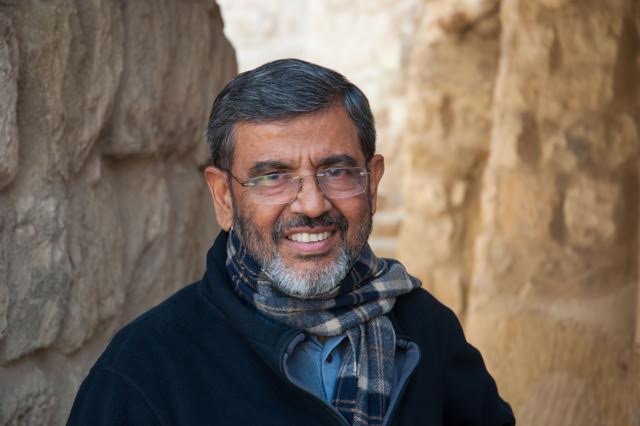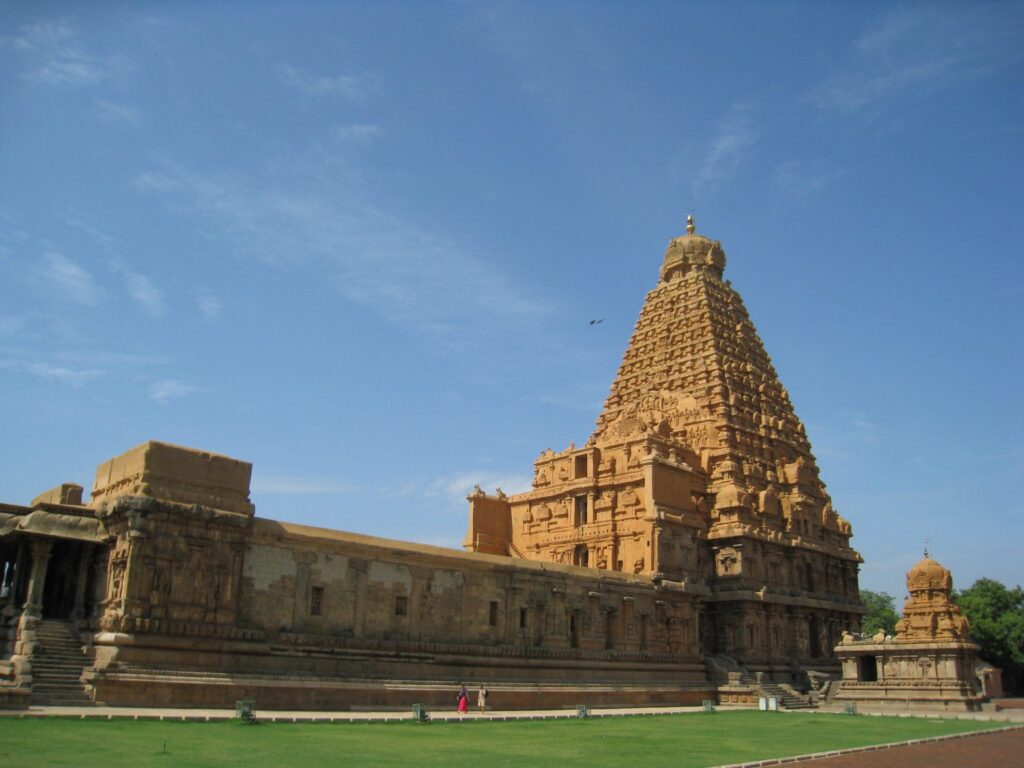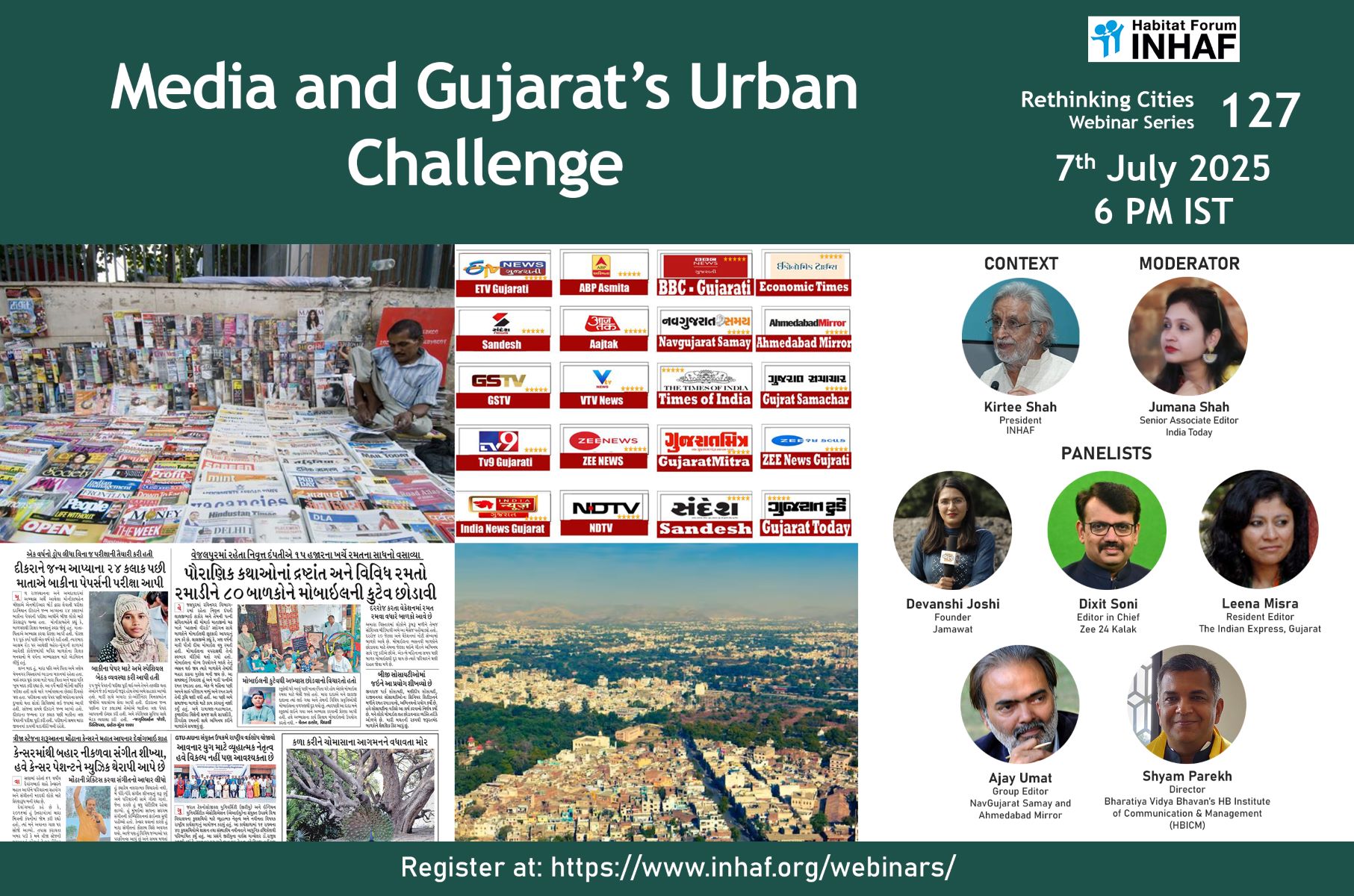Architectural Heritage in India: Conversations on Conservation, Preservation, Restoration series by ArchitectureLive! aims to shed light on the complex issues surrounding architectural heritage in India by drawing insights from a diverse array of experts, across India. It is also a way to throw light on the multifaceted challenges and emerging solutions in this critical domain. The series continues with our third conversation with Professor A.G.K. Menon.

Rajesh Advani:
What is the meaning of heritage, for you?
A.G.K. Menon:
When I talk about heritage, I have a different perspective. There is a dichotomy between what a scholar, a teacher, or an expert talks about, and that of the owner of that heritage. Heritage means different things to different people. We can talk about it in a different dimension, but heritage is our past and identity. It represents our grandfathers in a metaphorical sense.
We have the idea that heritage is of the past. However, the interpretation of the past can vary. The current government wants to interpret it in a particular way, while we want to put it differently. In family life, we’d never disown our grandfathers, yet we are quite willing to abandon our heritage. The present generation’s thinking of heritage as only monuments or that the heritage is not being given due importance has been a matter of great concern to me.
We have not understood the problem in architecture, urban planning, and heritage. We understood the symptoms of the problem. We understand that heritage is being wiped out and we have no respect for it. Those are all the symptoms.
Some years ago, I had a disagreement with a very good friend of mine, who is also a great architect, over the redevelopment of Chandni Chowk. His plans to modernise the area by adding toilets and substations in the middle were problematic. It showed a common problem—dealing with heritage by modifying it without understanding it. These complexities must be understood when we try to define heritage. You can be facile about it and say that heritage is the past or the monuments or rituals, or that heritage is not monuments.
But heritage cannot be only the past. It is also about the present. What Prem [Chandravarkar] was saying is that heritage has nothing to do with the past. It is about a certain attitude that society has in the present. That relationship is the critical thing. They defined the past according to their buildings, just as we define the present in the same way. If the definition of the present is the definition of heritage, then you have a definition of heritage. It has nothing to do with time but with the zeitgeist.
If you go deeper, it will boil down to the idea of modernity. If you begin to probe what modernity is, you will begin to understand what heritage is. While both are aspirational, we want to modernise heritage. How do you modernise heritage? You can’t do it by changing it, but by respecting, conserving, and living with it. Authenticity becomes the keyword. When you ask if all modern buildings are to be preserved, we get into authenticity.
Rajesh Advani:
There have been debates or discussions surrounding structures like the Hall of Nations, the destruction at Central Vista, or what was going to happen to Sardar Vallabh Patel Stadium in Gujarat or Kala Academy in Goa, where age is a factor used to determine if a building is heritage or not. How do these discussions reflect on our understanding of heritage, according to you?
A.G.K. Menon:
We went to court about the Hall of Nations because we were against its demolition as it was under consideration for being a heritage site. The High Court said quite honestly that they did not know what heritage is and that they would ask the Delhi Urban Art Commission (DUAC) for the definition of modern heritage. We agreed because we’ve been in dialogue with them for about 5 years about this. But they came up with a definition that said that the building had to be older than 60 years, and it [the Hall of Nations] was demolished because it was only 45 years old. Where did the figure of 60 years or 100 years come from? We instrumentalised this time period. Once you instrumentalise it, you get into a problem.
The age of the monument is just a tool, so we have faltered. When and how did we begin to falter? I don’t find this faltering in other civilisations, but I find it dramatically so in ours, especially in the last 70 years. It all comes back to the origins of the problem. When did this dissonance in spatial memory and temporal memory begin and continue to develop?
I might be a bit facetious here and take the liberty of saying when it happened exactly, but just for the sake of argument, I might say that spatial memory got broken in 1853, while our temporal memory (the memory of time) became dissonant in 1861. In 1853, the government said that government buildings would be built by the Central Public Works Department (CPWD), which has evolved over the years, witnessing independence and modernity.
But, in 1729, Jaipur (which is a modern city) was built. There were no references to any benchmarks other than itself. It had a very peculiar benchmark because it had a geographical issue, which the city managed to deal with in a particular way.
Any local solution has a local problem with our continuous understanding of what living is now.
Since 1853, because of the Britishers’ belief that Indians did not know how to build, they have told us how to build. You need contractors, bills of quantities, etc. The entire system got into place, developed, modernised, and became technologically advanced. So today, when we look at architecture, it has nothing to do with the vernacular tradition, though we are trying hard to bring it in. There is no continuity, showing the deep-rooted disconnection.
I will give you an example of town planning in 1876 that followed British guidelines for town planners. It was copied from English town planning and brought here. From then on, our spatial imagination got completely dissociated from our past.
So, today, when we have an urban problem, the government sends a group of experts to Shanghai or Singapore to find out how they solved the problem. We aren’t able to solve our own problems. Are we so far removed from what heritage means? In modern competitions conducted by the government, there is almost always a condition that you must have a foreign expert who has done so much work. It is all rooted in 1853, a binding to what is happening in Europe. If they do it, it’s advanced.
So, coming back to your questions on modernity, while it is seen as a Western narrative, modernity is an indigenous tradition. If it cannot be an indigenous tradition, you got an idea of modernity completely wrong, because, in the case of Jaipur, it was indeed an indigenous tradition. If the city was modernised in 1729, it can be done in 2015 as well. But our idea is always based on what they [the Europeans] have done. That’s the way we are taught, and that is the way we even conserve.
That is my problem with conservation. It wasn’t this way before. For instance, the Brihadishvara Temple was conserved for 1,000 years. People have been maintaining it for 1,000 years since Raj Chola built it. Yet when we come to modern monuments, or when we decide on how to conserve, we refer to what Europe is doing or what the charters say.
The Venice Charter is a beautifully written and very compelling document, but it is the product of their culture and technology, arising from a romantic movement. I questioned the Venice Charter, which is considered the benchmark of the conservation movement. Where did our understanding of conservation change?
There is a 1200-year-old temple in a village outside Chennai, Tamil Nadu, which is thought of as an important temple. People wanted to restore it because it was in ruins. You cannot restore a monument, as you have to keep a ruin as a ruin. They disagreed, saying that they had to restore it. It was restored by ex-ASI archaeologists who had spent a lifetime following the ideology of John Marshall and of ASI, which is all Eurocentric. When I talked to these archaeologists to ask why they did it, they spent a lifetime advocating the reverse, saying that the ruin must be kept as a ruin. And here they were going to the village as believers, feeling that the temple should be restored. Where did this epiphany come from? How can we restore this continuity?

Rajesh Advani:
There is an ongoing discussion where people or the government argue that urban development might disturb heritage but people shouldn’t be upset about it. There is also an insufficiency of policies, guidelines, and regulations in India. How do we resolve these conflicts and issues?
A.G.K. Menon:
Well, it is a complex subject that must be addressed. It’s not something we can escape without risking trivialisation. For example, regulations. Why does the government say that urban development and heritage are coming in each other’s way? That becomes a critical question. Where does this idea come from? It was not there in the design of Jaipur or the conservation of Brihadishvara Temple.
But today we say that heritage is coming in the way of urban development. In other words, heritage and development are binaries. How have we thought of heritage as anti-development?
This perspective is partly because of ASI parliamentary law that restricts activities within 100 metres of heritage sites and imposes stringent control for another 250 metres. Such laws may work in the low-density areas of Europe with controlled buffers, but in high-density places like Delhi, how does this work? That’s the problem. It’s a ‘one size fits all’ policy, yet the way buildings were conserved was not the same as the preservation of Brihadishvara Temple, Khajuraho, Palitana, or Konark.
I am going to go back to what is modern. [We think] modern is what is being done in Europe. What’s happening in Europe is now happening all over the country. Since we want a single political unity, we want a single cultural unity, and since we want cultural unity, we want a single law. Therefore, when we have preservation laws, we have a single law of 100 metres. Whether we’re in the middle of Delhi, in the Thar desert, or near a coast, the law remains the same, and that’s the problem.
We aspire to be a modern state, but we have not been able to understand how to define modernity. We’ve got an Indian way of governing, which is not the Westminster democracy that we have copied. Politics-wise, democracy has been redefined, but culture-wise, architecture has not, nor has music or dance. However, if we look at literature, modern Indian literature in Hindi is quite different from Malayalam or any other language. But if you talk about English, it’s the same everywhere. I’m just pointing out that they’re focused on how to define differences and get them together. Not difference as a separation, but difference as a unifier.
There’s this favourite phrase that is now being derided by the present government, ‘Unity and diversity’. In the beginning, we had come to the instinctive idea that our diversity must be unified. We are trying to homogenise diversity everywhere, including heritage and architecture. So, when talking about regulations, we are trying to homogenise India.
I’ll share an incident with the Monument Authority of India (when it was formed). I was invited to join the committee, but I eventually left because of our disagreements. They wanted uniform bylaws for all the monuments in India. On the other hand, the Commerce Department pushed for the development and building of roads and industry. That often conflicts with heritage conservation. When architects, conservationists, and town planners can’t have a dialogue with each other, how can the Commerce Ministry and the Culture Ministry? And unless they talk to each other, we cannot come up with an answer.
There is no standard master plan for any city, so how do you get into the idea of master planning? What’s master planning? It is a tabula rasa where you plan. Yet, when Delhi’s master plan was made, there were 300 villages, but the master plan was an empty piece of paper. When the land came up, places like Shahpur, Hauz Khas, etc. started coming up. Urban planners were disappointed that they were not following the urban plan.
In 2010, the government finally asked us what should be done. We had to re-plan Delhi, but we couldn’t wipe it out and say it did not happen. So, we prepared a local area plan for the 272 wards, which proposed changes for a better life based on the changes made through the master plan. This was an exercise in reverse. The question was how to remove this dichotomy between development and what had happened. But the urban planner was, of course, horrified to hear that we were changing the urban plan. You will have to mediate in some things while allowing others to modify.
The master plan is a tabula rasa, and yet there is no tabula rasa in India. You cannot do a master plan in India without understanding the context. So, when you start implementing the master plan and a temple comes in the way, what do you do with it? The answer is often to get rid of it. The government was not happy. The fees were to depend on the fact that if we approve it, they’ll pay you. We didn’t approve of it, and so they didn’t pay us.
In 2010, there was a similar problem with a highway being built near Agra, facing the Class 1 monument – Sikandra. The debate was so acrimonious that the authority said they would modify the master plan and the heritage by-laws so that this road could be built. I argued that Sikandra has already been there for 300 years, while the highway is only being planned. How do you deal with such a dilemma or a paradox of our heritage and development problems?
Rajesh Advani:
How can such conflicts between development and heritage preservation be addressed?
A.G.K. Menon:
In Banaras, for example, for 30 years we have been trying to re-plan the city. We have demonstrated viable plans and shown how they could be done. In India, about eight or nine conservation schools are focussing on teaching how to conserve heritage cities. But, because conservation is still a very nascent discipline, these efforts go unheard. We’re trying hard to show how the conservation of monuments does not have to be anti-development; we need intellectual and other space opportunities to achieve this.
I have had the privilege of having opportunities since the 1980s and have developed plans for cities like Varanasi, Ujjain, and Bhubaneshwar, proving that urban development and conservation can and should coexist. This approach is essential for solving our urbanisation, conservation, and architectural challenges.
Urban development and conservation can be done and should be done equivocally. It is the only way to plan our cities. It is the only way to take care of urbanisation and to solve our conservation, urban, and architecture problems.
Rajesh Advani:
What role can NGOs and communities play in this debate of development and heritage conservation, considering that it is not just the responsibility of those in power or decision-making positions, but also concerns everyone?
A.G.K. Menon:
The NGOs and communities are crucial and even work as watchdogs at times. But they have been suppressed to such an extent that they are not able to raise their voices, nor are they heard by a dominant government or authority.
For example, as a founding member of INTACH, an NGO, I have seen that INTACH embodies this spirit. In 2004, I created the INTACH Charter for Conservation on how to bring development and conservation together. Unfortunately, the last person who talks about it is INTACH itself. It is our tendency to want to please the government. The charter has been largely ignored, but it says very clearly that conservation is not a technical subject but a social subject that needs negotiation.
There are no experts who can define conservation and how things should be done because heritage has very much to do with society.
India is still a developing country, so our experiences will be different from those of the Venice Charter. Many people are doing their own conservation and development here. Even a slum is urban planning, if we change our perspective. Yet one is the enemy of the other. I have always been saying that planning has to be people-centric. Like the civilisation of Harappa had an order, so do the slums. All societies want order, but the mechanics and tools for achieving it vary.
Rajesh Advani:
What are some good international practices that you think India can follow or take inspiration from in the absence of regulations, policies, or frameworks?
A.G.K. Menon:
Well, I’m not the best person to ask about this, but I’ll share my perspective. Europe evolved organically over time and has organically modernised.
The question is, can we organically modernise India and develop what people have called indigenous modernity? We can learn from Europe, not by copying them, but by following the same methods and principles which look at the local context.
We should respect our traditions as we respect other traditions. As an urban planner, my role is to understand the context. I have tried to show how to plan an Indian city, but it is a difficult task. I can imagine Paris or London being Indianised which is a very simple urban planning process. But can we imagine an Indian city?
There was a competition for planning the new Raipur. We began with the proposition of planning a city that is new and respects the local context. When we presented the plan, the critics asked me about the winding roads, as they wanted the roads to be straight to have an order. We didn’t win the competition. The question I posed to them was, how do we design a capital after Chandigarh? That’s what the new Raipur is—a copy of Chandigarh. There should be a difference in how we design a capital city because so much has happened. What we’re doing now for ecology, environment, and society is important. We’ve had huge problems in urban planning as all our master plans are held up because of land acquisition.
How do we then design rapidly without acquiring land? How do we make sure that when the population becomes ten lakh, there’s still plenty of water? We can do it by being ecologically sensitive, by understanding the culture of the Adivasis who are cultivating the land with a beautiful landscape and plenty of water. We can design an ecologically sensitive city.
But this idea of modernity is quite different because when the bureaucrats of Raipur were saying that they wanted a new capital, obviously they wanted to challenge Chandigarh. Raipur is a poor state, in comparison to Chandigarh. That becomes a challenge for designing a capital, not where the capital is located. When the capital grows with people, will it still have enough resources? We can design a completely equitable city without the disparity between the rich and the poor.
A.G.K. Menon
Professor A.G.K. Menon is an architect, urban planner, and conservation consultant who has been practising in Delhi for over 40 years. He is actively engaged in research, and his contributions have been extensively published in professional journals and several academic books. He has also been actively involved in urban conservation and, in 2004, drafted the INTACH Charter for the Conservation of Unprotected Architectural Heritage and Sites in India. He is currently the convener of the Delhi chapter of INTACH. He was the first Dean of Studies at the TVB School of Habitat Studies and later its Director until the school was merged with Guru Gobind Singh Indraprastha University to become the University School of Architecture and Planning in 2007.
Credits:
Transcribing: Simran Gandhi
Editing: Geethu Gangadhar




One Response
Unfortunately all the decisions are either taken by politicians or IAS officers.
Whether it is heritage, planning or any other issue related to built environment,
Architects, Planners and /or Conservation experts are not in a position to dictate terms or give advise to them.
They can/may write articles in journals or give lectures in seminars.
Ashok Goel
Architect
Ashok Dilliwala Show on YouTube.